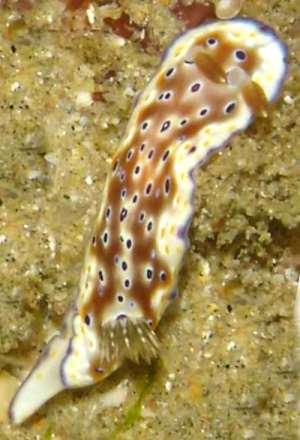Chromodoris tennentana from South Africa
May 4, 2007
From: Colin Ogden

Hi Bill.
Is this a Risbecia tryoni? All photos I have seen do not show the yellow spots below the mantle as reflected on this nudi. This one was also on its own without the normal mate!
Locality: Sodwana Bay, South Africa, Indian Ocean. Depth: 19 mts. Length: 30 mm. 04 June 2005. Coral reef. Photographer: Colin Ogden
Regards
Colin
scubaco@iafrica.com
Ogden C M, 2007 (May 4) Chromodoris tennentana from South Africa. [Message in] Sea Slug Forum. Australian Museum, Sydney. Available from http://www.seaslugforum.net/find/13967Dear Colin,
I am afraid this nice photo of Chromodoris tennentana has been languishing in the backlog of messages for too long. Your animal looks almost identical to a painting of a chromodorid from east Africa which Eliot named Chromodoris cavae. and which I later (Rudman, 1987) considered to be the same as C. tennentana. Much later, on the basis of a photo from Valda Fraser on the Forum [message #1521], I realised that they were indeed different. As numerous recent messages seem to show, C. cavae is very variable in colour, but there is one colour form which looks very similar to Chromodoris tennentana. Your animal is C. tennentana.
One obvious difference between the two species is the colour of the gills and rhinophores, in C. cavae they are white with purple tips, while in C. tennetana the rhinophores are reddish brown with a white tip and the gills are dark brown, sometimes with white spots. The gills and rhinophores in your animal are clearly those of C. tennentana. Another interesting feature of the colour pattern in your animal are the white spots in the centre of some of the dark purple spots. Eliot (1904) in his description of C. vicina from Zanzibar, which I consider to be a synonym of C. tennentana, specifically mentions that the larger violet spots have a white centre.
These white spots also indicate that this species may be related to the western Pacific species C. collingwoodi, which in specimens from Hong Kong [message #4802], can have similar white spots within the purple spots.
This is a valuable contribution to sorting out this group of species.
Best wishes,
Bill Rudman
Related messages
-
Chromodoris tennentana and C. vicina
From: Bill Rudman, May 4, 2007 -
Real Chromodoris tennentana from Sth Africa
From: Valda Fraser, November 13, 1999
